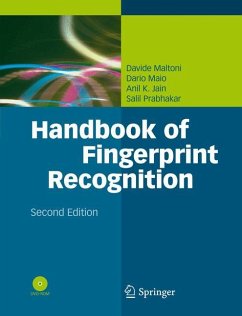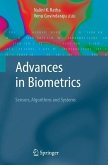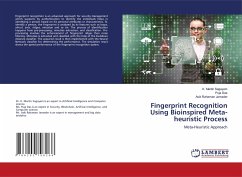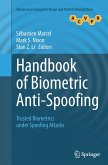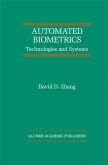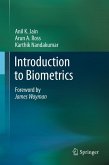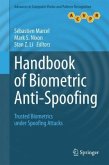With their proven distinctiveness and stability over time, fingerprints continue to be the most widely used anatomical characteristic in systems that automatically recognize a person's identity.
This markedly enhanced second edition provides in-depth coverage of the recent advances and practices in fingerprint recognition. Readers will find comprehensive and authoritative coverage of all the major concepts, topics, and systems and security issues associated with fingerprint recognition systems. Written with the same formula that made the success of the first edition, this unique professional reference includes state-of-the-art techniques in fingerprint matching, and covers developments in sensor technology, performance evaluation, international standards, and system security.
Features & Benefits:
_ Covers the latest research in fingerprint recognition algorithms and techniques
_ Reviews recent guidelines for scanner quality evaluation and certification, and provides examples of new fingerprint sensors
_ Provides introductory material on all components and modules of a fingerprint recognition system
_ Covers evaluations of fingerprint recognition algorithms and interoperability, including: FpVTE, MINEX, FVC2004 and FVC2006
_ Integrates numerous supporting graphs, tables, charts, and performance data
_Examines the design of secure fingerprint systems
_ Supplies an extensive annotated bibliography of citations and literature sources.
_ Contains helpful chapter overviews and summaries and consistent notation, for ease of use and accessibility
The revised edition of this indispensible reference, written by leading international researchers, covers all critical aspects of fingerprint security systems and technology. It is an essential resource for all security and biometrics professionals, researchers, practitioners, developers, and systems administrators, and can serve as an easy-to-read reference for a graduate course on biometrics.
Davide Maltoni is associate professor in the Department of Electronics, Informatics and Systems (DEIS) at the University of Bologna, where he also co-directs the Biometrics Systems Laboratory (BioLab).
Dario Maio is full professor in the University of Bologna's DEIS and a co-director of the BioLab. He holds two patents on fingerprint liveness detection.
Anil K. Jain is university-distinguished professor in the Department of Computer Science and Engineering at Michigan State University. He is a fellow of the IEEE, ACM and IAPR and holds six patents on algorithms for fingerprint recognition.
Salil Prabhakar is the Chief Scientist of DigitalPersona Inc., a leading provider of fingerprint identity solutions for consumers, enterprises, and custom application developers.
Key Topics
_ Fingerprint individuality
_ Fingerprint sensing
_ Biometric fusion
_ Synthetic fingerprint generation
_ Minutiae detection
_ Fingerprint system security
_ Performance evaluation
_ Feature extraction, matching, and indexing.
This markedly enhanced second edition provides in-depth coverage of the recent advances and practices in fingerprint recognition. Readers will find comprehensive and authoritative coverage of all the major concepts, topics, and systems and security issues associated with fingerprint recognition systems. Written with the same formula that made the success of the first edition, this unique professional reference includes state-of-the-art techniques in fingerprint matching, and covers developments in sensor technology, performance evaluation, international standards, and system security.
Features & Benefits:
_ Covers the latest research in fingerprint recognition algorithms and techniques
_ Reviews recent guidelines for scanner quality evaluation and certification, and provides examples of new fingerprint sensors
_ Provides introductory material on all components and modules of a fingerprint recognition system
_ Covers evaluations of fingerprint recognition algorithms and interoperability, including: FpVTE, MINEX, FVC2004 and FVC2006
_ Integrates numerous supporting graphs, tables, charts, and performance data
_Examines the design of secure fingerprint systems
_ Supplies an extensive annotated bibliography of citations and literature sources.
_ Contains helpful chapter overviews and summaries and consistent notation, for ease of use and accessibility
The revised edition of this indispensible reference, written by leading international researchers, covers all critical aspects of fingerprint security systems and technology. It is an essential resource for all security and biometrics professionals, researchers, practitioners, developers, and systems administrators, and can serve as an easy-to-read reference for a graduate course on biometrics.
Davide Maltoni is associate professor in the Department of Electronics, Informatics and Systems (DEIS) at the University of Bologna, where he also co-directs the Biometrics Systems Laboratory (BioLab).
Dario Maio is full professor in the University of Bologna's DEIS and a co-director of the BioLab. He holds two patents on fingerprint liveness detection.
Anil K. Jain is university-distinguished professor in the Department of Computer Science and Engineering at Michigan State University. He is a fellow of the IEEE, ACM and IAPR and holds six patents on algorithms for fingerprint recognition.
Salil Prabhakar is the Chief Scientist of DigitalPersona Inc., a leading provider of fingerprint identity solutions for consumers, enterprises, and custom application developers.
Key Topics
_ Fingerprint individuality
_ Fingerprint sensing
_ Biometric fusion
_ Synthetic fingerprint generation
_ Minutiae detection
_ Fingerprint system security
_ Performance evaluation
_ Feature extraction, matching, and indexing.
From the reviews:
"...a useful reference for all biometric security professionals and researchers. The four coauthors have a distinguished combination of academic and professional experience....Overall, readers will be pleased with the style and substance of this book." -Computing Reviews
"This is a comprehensive reviews of its topic ... . The thoroughness of the treatment of biometric methods is not obvious from the title. This feature will make the book particularly valuable in some robotics contexts. ... The intended audience includes researchers, practicing engineers, and students ... . The book is suggested as a reference book for a graduate course on biometrics. The material is clearly presented ... . This will certainly be a standard reference work in its field." (Alex M. Andrew, Robotica, Vol. 22, 2004)
"The book is the first reference on automatic fingerprint recognition and provides an in-depth survey of the fingerprint state-of-the-art, presenting the most recent advances in fingerprints ... . is ideally suited to researchers and students in biometrics, pattern recognition, forensics, image processing, and computer vision. In addition, it will be essential to developers of biometric solutions, biometric users ... as well as to project managers and system integrators and administrators involved in the analysis, design, and management of finger-print-based biometric systems." (Computer Spectrum, Issue 4, 2003)
"...a useful reference for all biometric security professionals and researchers. The four coauthors have a distinguished combination of academic and professional experience....Overall, readers will be pleased with the style and substance of this book." -Computing Reviews
"This is a comprehensive reviews of its topic ... . The thoroughness of the treatment of biometric methods is not obvious from the title. This feature will make the book particularly valuable in some robotics contexts. ... The intended audience includes researchers, practicing engineers, and students ... . The book is suggested as a reference book for a graduate course on biometrics. The material is clearly presented ... . This will certainly be a standard reference work in its field." (Alex M. Andrew, Robotica, Vol. 22, 2004)
"The book is the first reference on automatic fingerprint recognition and provides an in-depth survey of the fingerprint state-of-the-art, presenting the most recent advances in fingerprints ... . is ideally suited to researchers and students in biometrics, pattern recognition, forensics, image processing, and computer vision. In addition, it will be essential to developers of biometric solutions, biometric users ... as well as to project managers and system integrators and administrators involved in the analysis, design, and management of finger-print-based biometric systems." (Computer Spectrum, Issue 4, 2003)

